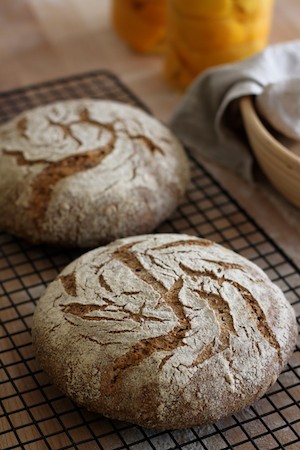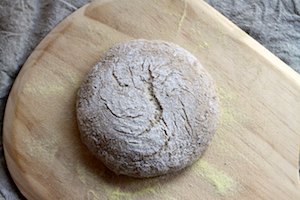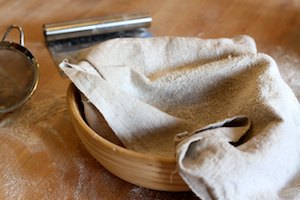
This is a variation on Seeded Multigrain Sourdough, one of my favorite breads for its reliability and versatility. It’s a great one to play around with, and playing around with your bread is highly encouraged!
For this one, I bumped the overall proportion of whole grain flour up to about 75% by using whole grain flours (equal parts spelt, wheat, and rye) instead of white flour in the final feeding of the starter, and increasing the amount of whole grain flour in the final dough as well. Because whole grain flours are extra thirsty, I also increased the water in the final dough.
Do not expect to get very good gluten development with this dough, because the gluten in spelt and rye is not very strong compared to wheat. Do expect, however, to get a chewy and flavorful bread that will keep well for several days!
Seeded Sourdough with Multigrain Starter
Yield: about 1000 g (2 loaves)
Time:
- Ferment multigrain starter (starting with a mature white starter): 12 hours
- Soak soaker: 30 minutes
- Mix final dough: 10 minutes
- First fermentation : 2.5 hours with folds at 50 and 100 minutes
- Preshape, rest, and shape: 35 minutes
- Proof: 2.5 – 3 hours
- Bake: 45 minutes
Desired dough temperature: 78F
Multigrain Starter Ingredients:
- 25 g mature 100%-hydration sourdough starter
- 33 g whole spelt flour
- 33 g whole wheat flour
- 33 g whole rye flour
- 99 g water
Soaker Ingredients:
- 33 g sunflower seeds
- 33 g pumpkin seeds
- 33 g sesame seeds
- 33 g flax seeds
- 46 g rolled oats
- 114 g water
Final Dough Ingredients:
- 132 g flour
- 132 g whole wheat flour
- 132 g whole spelt flour
- 100 g whole rye flour
- 12.5 g salt
- All of the multigrain starter
- 319 g water
- All of the soaker
Method:
- Combine the multigrain starter ingredients. Cover and ferment for 12 hours at room temperature.
- About 30 minutes before mixing the final dough, combine the soaker ingredients and cover.
- In the bowl of a stand mixer with a dough hook, combine all of the final dough ingredients except the soaker, holding back a small amount of the water. Mix in low speed to incorporate the ingredients. Adjust the water as needed to achieve a medium dough consistency.
- Continue mixing to a low-medium level of gluten development.
- Add the soaker and mix in low speed until it is evenly distributed through the dough.
- Transfer the dough to a lightly oiled container. Cover and ferment for 2.5 hours, with folds after the first 50 and 100 minutes.
- Turn the dough into a lightly floured counter. Divide into 2 pieces. Preshape into balls and let rest, covered, for 30 minutes.
- For the final shaping, use the flat of your hand to degas the dough into a disc. Gather the edges of the disk tightly into the center, then flip the ball over and rotate it on the countertop while using the edges of your hands to tuck the edges of the dough underneath. Most of this is done on an unfloured counter to provide friction needed to get the ball tight, but do the last couple of turns in coarse rye or whole wheat flour. Do not try to pinch the bottom seam closed.
- Place the dough, seam side down, into linen-lined baskets that have been generously dusted with the same flour.
- Proof, covered and at room temperature, for 2 – 3 hours, until the indentation left by a fingertip springs back slowly.
- Meanwhile, preheat the oven, with baking stone, to 500F. You will also need steam during the initial phase of baking, so prepare for this now.
- When ready to bake, turn the loaves onto the peel so that the floured side is up. Do not score the loaves.

- Once the loaves are in the oven, reduce the temperature to 450F. Bake for 10 minutes with steam, and another 25 minutes or so without steam. Then turn off the oven and leave the loaves in for another 10 minutes, with the door ajar.
- Cool on a wire rack.

wow what a process looks interesting to me…I should learn how to bake bread…I only do is cook main dish for my family never tried baking. I think I need to learn now =)
This looks deeply wholesome & beautiful, Susan! I love the natural cracks in the surface of the dough. I’m looking forward to trying this one.
Fabulous. I am always looking for new whole grain sourdough breads to try. This is perfect. Thanks for sharing!
Jonathan would adore this bread !
Stunning looking loaves Susan. It is a technique that is new to me – I’m very much looking forward to trying it. Thanks for sharing your knowledge.
As always, another stunning loaf. I’m amazed how you make a wholesome bread even healthier. All these whole grain flours make the process a little more labourious, I’m sure, but the result is a true feast for the eyes. How was the crumb – dense? And one more question – what did you serve this bread with? For some strange reason, I’m thinking gravlax on very thin slices…
Gravlax would great, although I had mine with cheese of various varieties. The crumb was dense, yes, but moist and chewy. Actually, it was less dense than I’d imagined, given the 75% or so of whole grain flour in here.
Last year I succumbed to family demands for satellite TV, convincing myself that by having some nature channels my young daughters would at least be kept away from the terrestrial channels. Much to my surprise my 7 year old has become addicted to Australian Master Chef and now wants to be a chef herself. Last weekend we were watching contestants using sour dough, so having this recipe to hand now is brilliant timing.
Thank you.
Hi Susan!
just a question: do your dough double in volume during 1º fermentation?
Thanks a lot!
beso
I have been looking for a good multi-grain sourdough recipe, so I tried this one this weekend. The taste did not disappoint, it is amazing. I will definitely make this again. This soaker flavour and texture is fantastic.
I did have a big issue with this bread though, and that is that even after 7 hours (total fermentation time at room temp.) my dough did not rise at all, nor did it rise in the oven. So I have a two small very flat delicious loaves. (One is almost gone, so it wasn’t a total bust. 🙂
This morning I went over the recipe and compared it to the 1,2,3 method, and the amounts vary considerably from that method. So I am thinking therein may be the problem. (after 12 hours, mixed as directed, my starter was beautiful and bubbly so I don’t think it was the problem.)
By the 1,2,3 method, this bread should be somewhere around the following amounts: starter: 223 g, total water: 446 g, total flour: 669 g. This recipe, by comparison: starter: 223 g, total water: 453 g, total flour: 496 g. Even if I add the oatmeal used in the soaker with the flour total, it still comes out much less, at 542 g.
So I am going to try this again using the same starter, and same soaker, same water (since I am assuming the soaker absorbs a bit of it and that could effect the 1,2,3 formula a bit) but adding 127 g more flour.
The taste of this bread is fabulous, so it is definitely worth to me to try tweaking this recipe! I’ll keep you posted. 🙂
So I tried it again, using all the water called for, and added 127 g hard white bread flour. I had a sticky dough that had some shape to it after kneading until the dough passed the window pane test. Because of time, I let it ferment the first time overnight in a cold room (between 50-60* F). It doubled very nicely. Then I proceeded as described in the recipe.
I didn’t score the loaves, as instructed, but I think I should have, because both loaves split along the sides. Maybe this is because I made oblong loaves instead of round?
Anyway the bread turned out beautifully, with the same fabulous taste that made me love this recipe enough to try it again, and now with a nice rise and grain to it as well. Thank you! 🙂